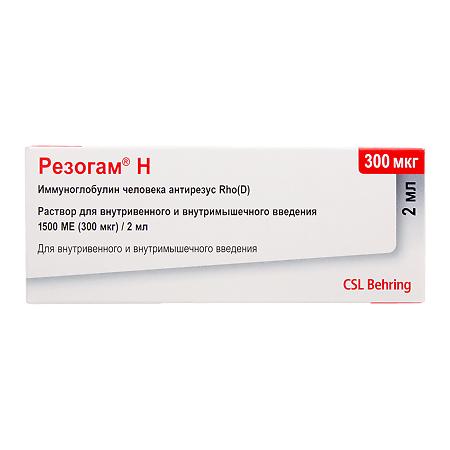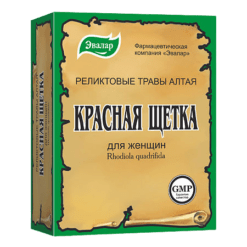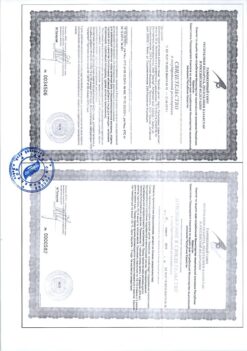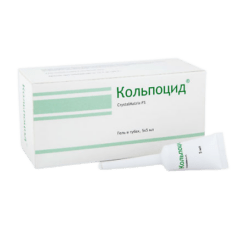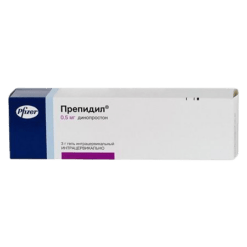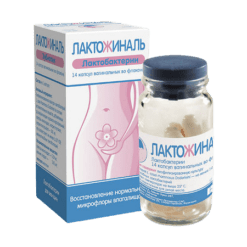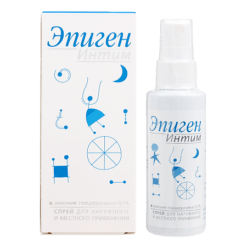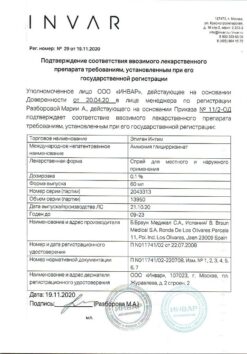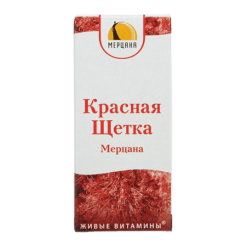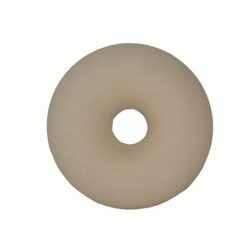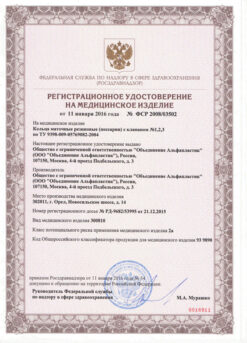No products in the cart.
Resogam H, 1500 me (300 mcg)/2ml 2 ml syringes with needle
€1.00
Out of stock
(E-mail when Stock is available)
Description
Pharmacotherapeutic group
MIBP-globulin
ATC code
J06BB01
Pharmacodynamics:
Rezogam® H contains IgG class specific antibodies against the Rho(D) rhesus antigen of human red blood cells. During pregnancy and especially during childbirth fetal red blood cells can enter the mother’s bloodstream. If the woman is Rh-negative and the fetus is Rh-positive the woman may be immunized with the Rh antigen resulting in the production of anti-Rh antibodies that pass through the placenta and can cause hemolytic disease in the newborn. Passive immunization with human anti-Rhesus immunoglobulin prevents Rh immunization in more than 99% of cases if a sufficient dose of anti-Rhesus immunoglobulin is administered in advance of exposure to Rh-positive fetal red blood cells.
The mechanism by which human anti-Rhesus immunoglobulin suppresses immunization to Rhesus-positive red blood cells is unknown. The suppression may be due to the removal of red blood cells from the bloodstream before they reach immunocompetent sites or there may be more complex mechanisms involving recognition of foreign antigens and presentation of antigens by appropriate cells on appropriate structures in the presence or absence of the antibody.
Pharmacokinetics:
A measurable antibody content can be obtained approximately 4 hours after intramuscular administration. Maximum serum concentrations are usually reached after 5 days. After intravenous injection, measurable antibody values are determined immediately after injection.
The elimination half-life of human anti-Rhesus immunoglobulin is 3-4 weeks. The half-life can vary from patient to patient. The average half-life from the circulation in pregnant women with normal IgG levels was 17 days.
IgG and complexes with IgG are degraded in cells of the reticuloendothelial system.
Indications
Indications
Prevention of Rh-positive immunization of Rh-negative women not sensitized to the Rho(D) antigen:
– prenatal prevention;
– prenatal prevention of pregnancy complications: abortion or threatened abortion, ectopic pregnancy or molar pregnancy; intrauterine fetal death transplacental transfusion as a result of antepartum hemorrhage amniocentesis chorionic villus sampling obstetric manipulations such as external obstetric rotation invasive intervention cordocentesis abdominal trauma or therapeutic intrauterine intervention;
– postpartum prevention.
Treatment of Rh-negative patients after transfusion of incompatible Rh-positive blood or other preparations containing red blood cells.
Pharmacological effect
Pharmacological effect
Pharmacotherapeutic group
MIBP – globulin
ATX code
J06BB01
Pharmacodynamics:
Rezogam® N contains specific IgG antibodies against the Rh antigens Rho(D) of human erythrocytes. During pregnancy and especially during childbirth, fetal red blood cells can enter the mother’s bloodstream. If the woman is Rh negative and the fetus is Rh positive, the woman can be immunized with the Rh antigen, as a result of which she develops anti-Rh antibodies that pass through the placenta and can cause hemolytic disease of the newborn. Passive immunization with human anti-Rhesus immunoglobulin prevents Rh immunization in more than 99% of cases, provided that a sufficient dose of anti-Rhesus immunoglobulin is administered well before exposure to Rh-positive fetal red blood cells begins.
The mechanism by which human anti-Rhesus immunoglobulin suppresses immunization to Rh-positive erythrocytes is unknown. Suppression may be due to the clearance of red blood cells from the bloodstream before they reach immunocompetent sites, or there may be more complex mechanisms involving the recognition of foreign antigens and the presentation of antigens by the appropriate cells on the appropriate structures in the presence or absence of an antibody.
Pharmacokinetics:
Measurable antibody levels can be obtained approximately 4 hours after intramuscular administration. Maximum serum concentrations are usually achieved after 5 days. After intravenous administration, measurable antibody levels are determined immediately after injection.
The half-life of human anti-rhesus immunoglobulin is 3-4 weeks. The half-life may vary from patient to patient. The mean circulation half-life in pregnant women with normal IgG levels was 17 days.
IgG and complexes with IgG are destroyed in the cells of the reticuloendothelial system.
Special instructions
Special instructions
In the case of postpartum use, human anti-rhesus immunoglobulin is intended for administration to the mother.
This drug is not intended for administration to Rh-positive patients or patients already immunized to the Rho(D) antigen.
Patients should be observed for at least 20 minutes after administration of the drug.
If an allergic or anaphylactic reaction develops, you must immediately stop administering the drug.
Allergic reactions to the administration of human anti-rhesus immunoglobulin may occur. Patients should be made aware of early signs of hypersensitivity reactions including urticaria, generalized urticaria, difficulty breathing, wheezing, hypotension and anaphylaxis. The necessary treatment measures depend on the nature and severity of the side effect. In case of shock development, standard anti-shock drug therapy should be carried out.
It was found that the concentration of IgA in the drug Rezogam® N is below the detectable value of 5 μg/ml. However, this drug may contain trace amounts of IgA. Although human anti-Rhesus immunoglobulin has been successfully used in the treatment of patients with selective IgA deficiency, individuals with IgA deficiency may develop antibodies to IgA and experience anaphylactic reactions to the administration of blood components containing IgA. Therefore, the doctor must evaluate the benefits of prescribing Rezogam® N and the risk of possible hypersensitivity reactions.
Safety information regarding infectious agents
Standard measures to prevent the transmission of infections due to the use of medicinal products made from human blood or plasma include donor selection, screening of individual donations and plasma pools for the presence of specific markers of infection, and the inclusion of effective manufacturing steps aimed at inactivating and/or removing viruses. Despite this, when using drugs obtained from human blood or plasma, the possibility of transmitting infectious agents cannot be completely excluded. This provision also applies to unknown or new viruses and other infectious agents. The measures taken are considered effective against enveloped viruses such as HIV, hepatitis B and C viruses. They may be partially effective against non-enveloped viruses such as hepatitis A virus and parvovirus B 19.
There is encouraging clinical experience showing no cases of transmission of hepatitis A viruses or parvovirus B 19 with immunoglobulins and it is also assumed that the antibodies contained in the drug make an important contribution to increasing antiviral safety.
It is strongly recommended that each time Rezogam® N is administered to a patient, the name and batch number of the drug are recorded in order to maintain the connection between the patient and the batch of the drug.
Rezogam® N should not be mixed with other drugs since interactions with other drugs have not been studied.
The drug is intended for single use (one syringe – one patient). Unused drug or its remains should be disposed of in accordance with current requirements.
Do not use the drug after the expiration date indicated on the syringe label and cardboard box.
Impact on the ability to drive vehicles. Wed and fur.:
There was no effect of the drug Rezogam® N on the ability to drive a vehicle or operate moving mechanisms.
Active ingredient
Active ingredient
Human anti-rhesus immunoglobulin Rho (D)
Composition
Composition
in 1 ml
in 2 ml
(in filled syringe)
Active ingredient:
Human anti-rhesus immunoglobulin
750 ME
1500 ME
Rho(D)
(150 mcg)
(300 mcg)
Excipients:
Human albumin
10 mg
20 mg
Glycine
20.6 mg
41.2 mg
Sodium chloride
≤0.250 mmol
≤0.500 mmol
Acetic acid
q.s. up to pH=5.2
q.s. up to pH=5.2
Water for injections
q.s. up to 1 ml
q.s. up to 2 ml
Rezogam® N contains no more than 30 mg/ml human plasma proteins, of which 10 mg/ml human albumin (stabilizer), at least 95% of other proteins are IgG immunoglobulins; IgA content not more than 5 μg/ml.
Pregnancy
Pregnancy
Pregnancy
Rezogam® N can be used during pregnancy.
There were no reported side effects associated with the use of the drug in children born to mothers who received Rezogam® N in the prenatal period.
Breastfeeding period
Rezogam® N can be used during breastfeeding. Immunoglobulins are excreted in milk. There were no reported side effects associated with the use of the drug in children born to mothers receiving Rezogam® N in the postpartum period.
Contraindications
Contraindications
– Hypersensitivity to the active substance or any other component of the drug;
– increased sensitivity to human immunoglobulins;
– the intramuscular route of administration is contraindicated in persons with severe thrombocytopenia or other hemostasis disorders;
– Rh-negative postpartum women sensitized to the Rho(D) antigen in whose blood serum Rh antibodies are detected;
– newborns.
Side Effects
Side Effects
Adverse reactions presented below are listed in accordance with damage to organs and organ systems (MedDRA classification) and frequency of occurrence. The frequency of occurrence is determined as follows: very often (≥1/10) often (≥1/100 and <1/10) uncommon (≥1/1000 and <1/100) rarely (≥1/10,000 and <1/1,000) very rarely (<1/10,000 including isolated cases). Frequency categories were formed based on clinical studies of the drug and post-registration surveillance.
Frequency of occurrence of adverse reactions
Classification of adverse reactions according to damage to organs and organ systems (MedDRA)
Clinical manifestations
Category
frequencies
occurrence
Immune system disorders
Hypersensitivity anaphylactic shock
Rarely
Nervous system disorders
Headache
Uncommon
Heart disorders
Tachycardia
Rarely
Vascular disorders
Arterial hypotension
Rarely
Disorders of the respiratory system of the chest and mediastinum
Dyspnea
Rarely
Gastrointestinal disorders
Nausea vomiting
Rarely
Skin and subcutaneous tissue disorders
Skin reactions erythema itching
Uncommon
Musculoskeletal and connective tissue disorders
Arthralgia
Rarely
General and administration site disorders
Fever, feeling of discomfort, chills
Uncommon
At the injection site: swelling pain erythema induration feeling of heat itching rash
Rarely
Interaction
Interaction
Interaction with other drugs has not been studied. The information presented in this section is obtained from literature sources and current guidelines.
Live attenuated viral vaccines
Active immunization with live viral vaccines (for example, measles, rubella, mumps or chickenpox vaccines) should be delayed until three months after the last administration of human anti-Rhesus immunoglobulin because the effectiveness of live viral vaccines may be reduced. If there is a need to administer anti-Rhesus human immunoglobulin 2-4 weeks after the administration of a live viral vaccine, the effectiveness of such vaccination may be insufficient.
After injection of immunoglobulin, a transient increase in passively transferred antibodies in the blood of patients can lead to false-positive results when conducting a serological test of antibodies against red blood cells, for example, when performing a Coombs test in newborns.
Rezogam® N may contain antibodies to other Rh antigens, for example anti-Rh(C), which can be determined by sensitive serological methods after administration of the drug.
Overdose
Overdose
There is no data on drug overdose. Patients who received very large doses of human anti-Rhesus immunoglobulin after transfusion of incompatible blood components should be monitored for clinical and biochemical indicators due to the risk of developing a hemolytic reaction. In other cases, overdose in Rh-negative patients should not result in more frequent or more severe side effects than those observed with normal doses.
Storage conditions
Storage conditions
Store at a temperature of 2 to 8°C, protected from light.
Keep out of the reach of children.
Shelf life
Shelf life
3 years.
Do not use after the expiration date indicated on the package.
Manufacturer
Manufacturer
CSL Behring AG, Switzerland
Additional information
| Shelf life | 3 years. Do not use after the expiration date on the package. |
|---|---|
| Conditions of storage | Store at 2 to 8°C in a light-protected place. Store out of the reach of children. |
| Manufacturer | CSEL Bering AG, Switzerland |
| Medication form | solution |
| Brand | CSEL Bering AG |
Related products
Gynecology and Obstetrics
Prepidil, intracervical gel 0.5 mg/3 g syringes with catheter
Gynecology and Obstetrics
Buy Resogam H, 1500 me (300 mcg)/2ml 2 ml syringes with needle with delivery to USA, UK, Europe and over 120 other countries.

